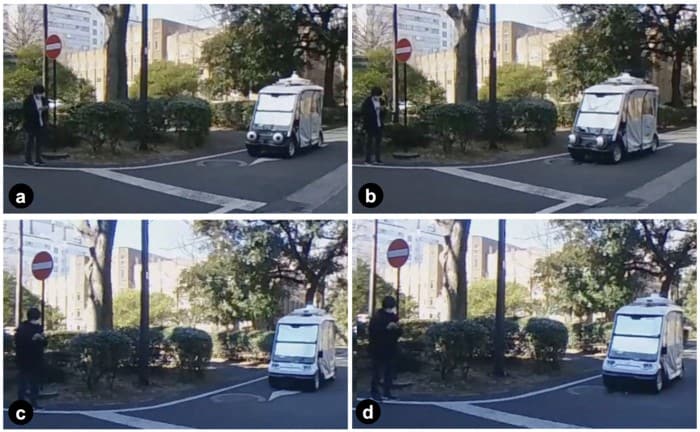When walking in an area that is busy with cars, most people will focus their gaze on the driver of a vehicle, rather than the vehicle itself. This is both to ensure that the driver has seen them and to gauge where the car will go next. googletag.
cmd. push(function() { googletag. display(‘div-gpt-ad-3759129-1’); }); Some people, however, are unable to see fine details such as where a driver is looking and, in the future, self-driving cars will not have a human driver to look at.
Now researchers in Japan have done a study that suggests a way of addressing these problems. Takeo Igarashi and colleagues at the University of Tokyo fitted a self-driving electric golf cart with a large pair of eyes with pupils that move in unison to make it appear that the vehicle is looking in a specific direction. Virtual road crossing They did an experiment in which people waiting to cross a road are approached by the cart with eyes and without eyes and decide what to do.
For safety reasons, the participants viewed the scenarios using a virtual reality system, rather than walking out in front of a real golf cart. In some cases, the eyes were focused on the pedestrian – indicating that the self-driving system had recognized that someone was about to cross the road and would stop. In other cases the eyes looked away, indicating that the vehicle was oblivious to the pedestrian and would not stop.
The team found that overall, the subjects were able to use the information provided by the eyes to make better judgements when crossing the road. However, they did find that male participants made more unsafe crossings that female subjects. While some participants found the eyes endearing, others said that they were creepy.
The eyes have it Aesthetics aside, Igarashi and colleagues believe that fitting self-driving cars with some sort of robotic eyes could reduce collisions with pedestrians. Indeed, they plan to build a self-driving vehicle in which the navigation computer sets the direction of the eyes when it detects a pedestrian (the eyes in their recent experiment were set manually). Igarashi says, “I hope this research encourages other groups to try similar ideas, anything that facilitates better interaction between self-driving cars and pedestrians, which ultimately saves people’s lives”.
The research was presented at 14th International Conference on Automotive User Interfaces and Interactive Vehicular Applications in Seoul. Martian hike Negotiating a busy carpark can be dangerous but is has nothing on walking on Mars. Even if you could get there, you would have to endure very chilly temperatures and a distinct lack of oxygen.
Fortunately, Sebastian Walter at the Free University of Berlin and colleagues have created a virtual Martian hike that you can enjoy from the comfort of your own home. The interactive map guides you across the Jezero crater, which is currently being explored by NASA’s Perseverance Rover. Indeed, many of the images and sounds used to create the experience have been gathered by that mission.
The base layer of the map was created using data from three different instruments that are currently orbiting the Red Planet. Virtual hikers can zoom in on images that they encounter and can also pan across Martian vistas. Walter says, “The map is the perfect tool for planning a future visit to Mars, with an interactive interface where you can choose from different available base datasets.
Some of the slopes are pretty steep, so watch out for those if you want to avoid too much oxygen consumption!”. While the map was originally developed to get the public interested in Mars, Walter believes that it could develop into a research tool as more data from Perseverance are included. The post Cars with robotic eyes could make pedestrians safer, take a virtual hike on Mars appeared first on Physics World.
.
From: physicsworld
URL: https://physicsworld.com/a/cars-with-robotic-eyes-could-make-pedestrians-safer-take-a-virtual-hike-on-mars/
